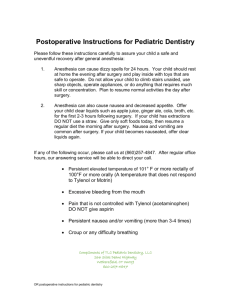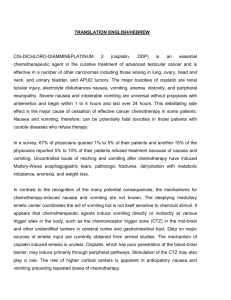Post‐Operative Nausea & Vomiting - Scottish Universities Medical
advertisement
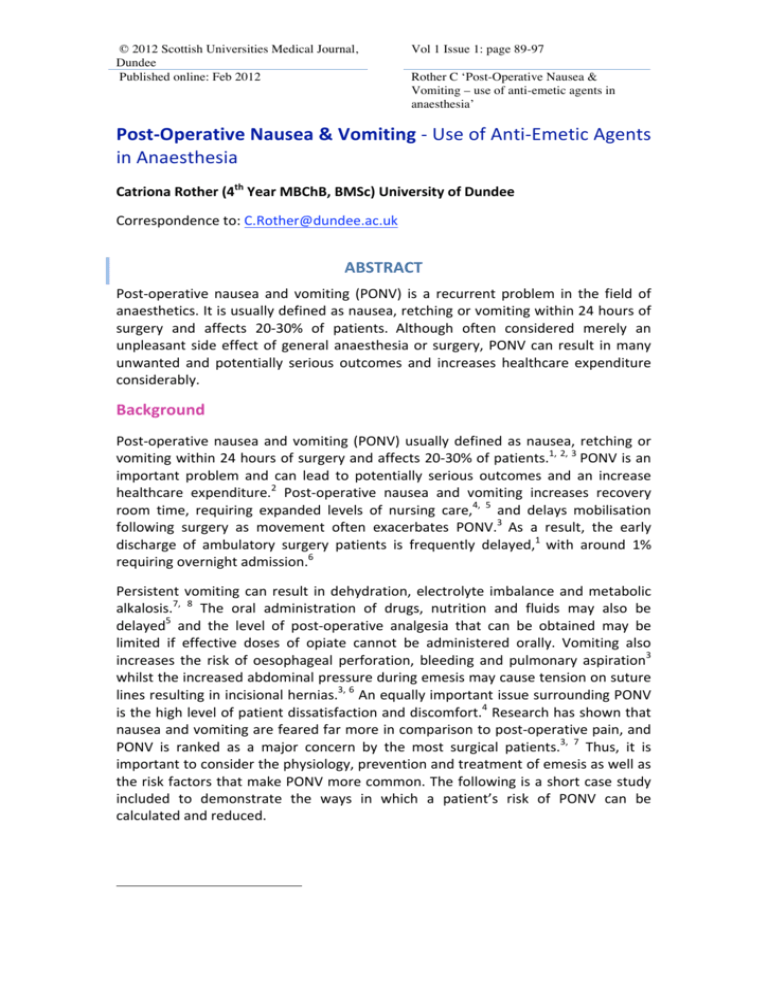
© 2012 Scottish Universities Medical Journal, Dundee Published online: Feb 2012 Vol 1 Issue 1: page 89-97 Rother C ‘Post-Operative Nausea & Vomiting – use of anti-emetic agents in anaesthesia’ Post‐Operative Nausea & Vomiting ‐ Use of Anti‐Emetic Agents in Anaesthesia Catriona Rother (4th Year MBChB, BMSc) University of Dundee Correspondence to: C.Rother@dundee.ac.uk ABSTRACT Post‐operative nausea and vomiting (PONV) is a recurrent problem in the field of anaesthetics. It is usually defined as nausea, retching or vomiting within 24 hours of surgery and affects 20‐30% of patients. Although often considered merely an unpleasant side effect of general anaesthesia or surgery, PONV can result in many unwanted and potentially serious outcomes and increases healthcare expenditure considerably. Background Post‐operative nausea and vomiting (PONV) usually defined as nausea, retching or vomiting within 24 hours of surgery and affects 20‐30% of patients.1, 2, 3 PONV is an important problem and can lead to potentially serious outcomes and an increase healthcare expenditure.2 Post‐operative nausea and vomiting increases recovery room time, requiring expanded levels of nursing care,4, 5 and delays mobilisation following surgery as movement often exacerbates PONV.3 As a result, the early discharge of ambulatory surgery patients is frequently delayed,1 with around 1% requiring overnight admission.6 Persistent vomiting can result in dehydration, electrolyte imbalance and metabolic alkalosis.7, 8 The oral administration of drugs, nutrition and fluids may also be delayed5 and the level of post‐operative analgesia that can be obtained may be limited if effective doses of opiate cannot be administered orally. Vomiting also increases the risk of oesophageal perforation, bleeding and pulmonary aspiration3 whilst the increased abdominal pressure during emesis may cause tension on suture lines resulting in incisional hernias.3, 6 An equally important issue surrounding PONV is the high level of patient dissatisfaction and discomfort.4 Research has shown that nausea and vomiting are feared far more in comparison to post‐operative pain, and PONV is ranked as a major concern by the most surgical patients.3, 7 Thus, it is important to consider the physiology, prevention and treatment of emesis as well as the risk factors that make PONV more common. The following is a short case study included to demonstrate the ways in which a patient’s risk of PONV can be calculated and reduced. Case Study: Patient A Case Background Patient A is an 81‐year‐old gentleman, undergoing a sigmoid colectomy to treat colorectal cancer. He has no history of motion sickness and has had 2 previous anaesthetics without complication. He is otherwise well and takes no regular medications. Patient A stopped smoking over 30 years ago. The operation is carried out using a midline laparotomy and lasts approximately 4 hours. Total intravenous anaesthesia (TIVA) is used with Propofol administered for both induction and maintenance of anaesthesia. Remifentanil, a short‐acting opioid, is administered alongside TIVA and Patient A is also given a thoracic epidural, which should provide extremely effective pain relief for 48‐72 hours post‐operatively. Risk Factors for PONV There are several factors that increase the likelihood of PONV. These factors can generally be separated into patient factors, surgical factors and pharmacological factors. PATIENT FACTORS INCREASING THE RISK OF PONV: • • • • • Female gender (especially if menstruating or pregnant)3, 4, 11 Previous history of PONV3, 4 Previous history of motion sickness3, 4 Non‐smoking status3, 4 Age (young children are most at risk of PONV, although this risk decreases with puberty)10 Case Study: Patient A [Patient Hx] Smoking appears to be protective so Patient A’s non‐smoking status places him at an increased risk of suffering from PONV. SURGICAL FACTORS INCREASING THE RISK OF PONV: Surgeries associated with increased risk of PONV: o Laparoscopy o Laparotomy o ENT surgery o Neurological surgery o Breast surgery o Gynaecological surgery4 Duration of surgery (the risk of PONV increases with the length of the surgical procedure)4 • Case Study: Patient A [Surgery] The midline laparotomy used in Patient A’s operation stimulates the vagus nerve, which can produce emetogenic effects. The surgery also lasted approximately 4 hours, further increasing the risk of PONV. PHARMACOLOGICAL FACTORS INCREASING THE RISK OF PONV: • Anaesthetic techniques associated with increased risk of PONV: o General anaesthesia (increases the risk of PONV 11‐fold compared to regional anaesthesia) 4 o Use of volatile anaesthetic agents o Use of nitrous oxide o Use of reversal agents eg. Neostigmine o Use of opioids either intra‐ or post‐operatively8 Case Study: Patient A [Pharmacology] Unfortunately, in the case of Patient A, regional anaesthesia cannot be used. Instead, total intravenous anaesthesia was used with Propofol administered for both induction and maintenance of anaesthesia. Generally, this approach results in a reduced ‘hangover effect’ and less post‐operative nausea than maintaining anaesthesia with volatile agents or nitrous oxide.5 Patient A was given a single bolus of the muscle relaxant Rocuronium at the beginning of the surgery. As the surgery lasts approximately 4 hours, however, it was decided that no reversal agents were required and so the emetic effect of Neostigmine was avoided. Pain is a very common cause of emesis.12 For this reason, effective pain relief is vital in preventing PONV. Narcotic analgesics such as morphine, however, decrease gut motility and often lead to constipation and nausea.7 The emetic effect of these drugs can be minimised with the use of short‐acting opioid drugs6 such as Remifentanil, used in the case of Patient A. As mentioned previously, Patient A was also given a thoracic epidural to combat post‐operative pain. OTHER FACTORS INCREASING THE RISK OF PONV: • • • • Inexperienced anaesthetic technique9 e.g. Poor bag and mask ventilation may cause gastric distension and subsequent nausea. Poor hydration during or immediately following surgery4 Intra‐operative hypotension4 Patient stress/anxiety5 Case Study: Patient A [Other Factors] Throughout the surgery, Patient A was kept well hydrated with 3 litres of Hartmann’s solution and 500mls of Gelofusine. He was kept well oxygenated which has been shown to reduce from the probability of PONV by 50%.6 Hypotension was also avoided using Metaraminol and Ephedrine. It has been suggested that a patient may be less likely to experience PONV if they are calm prior to surgery and well informed regarding what to expect post‐ operatively.5 Patient A was not particularly anxious prior to surgery. The operation was explained well and he was aware of the potential complications that could arise in the post‐operative period. Case Study: Calculating the Risk of PONV for Patient A It is important to identify any factors that increase the likelihood of PONV in order to attempt to reduce a patient’s baseline risk. There are many different tools that can be used to quantify this risk such as the Apfel scoring system where each additional risk factor increases a patient’s risk of PONV by 20%.8 The sensitivity and specificity of these scoring systems, however, is generally only around 70%6 so it remains fairly difficult to predict with any great certainty which patients will be affected. It is useful to determine those at a higher risk of PONV, as this can be used to decide which patients will benefit from prophylaxis and reduces the risk of medication side effects and costs for those that are unlikely to benefit.4 The relative indication for prophylaxis increases with the number of risk factors.5 Patient A was determined as having a mild risk of suffering from PONV. Intraoperatively, Granisetron was administered around 30 minutes prior to the surgical closure of the abdomen. Cyclizine was prescribed for the recovery room andboth Cyclizine and Ondansetron were prescribed for the ward to be administered on an ‘as required’ basis. Physiology of Nausea and Vomiting Before the pharmacology of anti‐emetic drugs can be considered an understanding of the physiology and aetiology of nausea and vomiting is required. Emesis or vomiting is defined as ‘the reflex action of ejecting the contents of the stomach through the mouth’.13 It is controlled by a group of closely related nuclei in the brainstem termed the ‘vomiting centre’ that is rich in dopaminergic, histamine, 5‐ hydroxytryptamine, neurokinin and muscarinic cholinergic receptors.5 When the vomiting centre is stimulated, a complex series of neural impulses coordinates the simultaneous relaxation of the gastric muscles and contraction of the abdominal muscles and diaphragm, expelling vomit from the stomach.8 Nausea, often the precursor to vomiting, is triggered by a low level of the same stimuli responsible for the vomiting reflex but the exact mechanism underlying the sensation of nausea is unclear.5 It is often accompanied by salivation, sweating and pallor.8 The ‘vomiting centre’, located in the lateral reticular formation of the medulla9 and receives input from a wide variety of afferent sources. Input from mechanoreceptors and chemoreceptors in the GI tract is carried via the vagus nerve, involving 5HT and dopamine receptors.5 Other inputs include those from the vestibular system, the cardiovascular system, the pharynx and more complex stimuli from higher cortical centres responding to pain, fear and anxiety.9 There is also input from an area known as the ‘chemoreceptor trigger zone’ or CTZ. This is located in the area postrema of the medulla and is very sensitive to emetic stimuli, with abundant 5HT and dopaminergic receptors.9 It responds to toxins in both the blood and cerebrospinal fluid, and communicates with the vomiting centre. Many different types of surgery stimulate the vomiting centre as do various peri‐ operative drug types and anaesthetic agents, explaining why nausea and vomiting are such common complaints following surgery.5 The vomiting centre integrates these various inputs and then coordinates the efferent branches of cranial nerves V, VII, IX and X and organises the muscular contractions and cardiovascular responses used during emesis.7 Figure 1 demonstrates the afferent inputs to the vomiting centre and the site of action of some anti‐emetic drugs Figure 1: Adapted from Pleuvry BJ. Physiology and pharmacology of nausea and vomiting. Receptor Types Arrow Size Histamine 1 (H1) Small [site of drug action] Muscarninc (Ach) Large [Neuronal Pathway] Dopamine 2 (D2) Neurokinin (NK‐1) 5‐Hydroxytryptamine 3 (5‐HT3) Management of PONV It is generally an easier task to prevent nausea and vomiting than to treat it. Anti‐ emetics used in anaesthesia can generally be thought of as those prescribed for prophylaxis and those prescribed for ‘rescue’, or to treat PONV. Prophylactic anti‐emetics are usually prescribed following departmental guidelines and protocols, depending on a patient’s risk of sickness following surgery. Prophylactic anti‐emetics are rarely warranted in low risk patients.3 Moderate risk patients may benefit from treatment with a single anti‐emetic.3 If a patient is at high risk of suffering from PONV or if vomiting would be particularly problematic, for example, in patients with raised intracranial pressure or wired jaws, combination therapy is often used.3 Neurotransmitters implicated in the control of nausea and vomiting include acetylcholine, dopamine and 5‐HT.9 Anti‐emetics generally act as antagonists to one or more of these neurotransmitters6 and many act via more than one mechanism. Using a combination of different anti‐emetics that work via different neurotransmitters gives an additive or synergistic effect.14 Rescue therapy is indicated for patients in whom prophylaxis has failed and should be administered as soon as signs of nausea or vomiting occur with the prescribed drug being from a different class to the failed prophylactic drug.6 If there is no improvement in symptoms within 30 minutes, treatment should proceed to the next line of therapy.6 The commonly used drugs in the management of PONV are indicated in Table 1. Due to the wide variety of different neurotransmitters involved in emesis, it is difficult to say which class of anti‐emetic agents are most effective, as no one anti‐ emetic will treat PONV for all patients.8 Most comparative studies have shown very similar efficacies between different anti‐emetics, though their side effect profile and cost differ. One trial suggests that Ondansetron, Droperidol and Dexamethasone all reduce the risk of PONV by approximately 26%.3 5HT3 receptor antagonists and Dexamethasone are currently considered the most effective first‐line prophylactic agents due to their favourable side effect profile and relative safety.17 Non‐Pharmacological treatment options Non‐pharmacological treatments can also be used in the management of PONV. These methods are required prior to surgery and have been shown to be very effective in some patients.8 Examples of non‐pharmacological treatments include: • • • • Acupuncture Acupressure TENS machine treatment Hypnosis2 It should be noted that in patients with prolonged vomiting or who do not respond to combined rescue therapy, it is important to consider alternative causes of PONV. These could include complications of surgery, hypotension or hypoxaemia or other more sinister underlying problems that are being overlooked, such as intestinal obstruction. Table 1‐ Commonly used drugs in the management of PONV Drug Class [& Mechanism & Site of Side Effects examples] Action Comments 5HT3 receptor antagonists Shown to reduce PONV by 26%. Ondansetron, Granisetron Antihistamines Cyclizine, Promethiazine Selectively antagonise 5HTs 8 receptors ‐ Centrally at the chemoreceptor trigger zone Favourable side effect profile. Headache. Constipation. Block histamine receptors in the 8 vomiting centre. Dry mouth. 8 Droperidol Antagonise dopamine and alpha‐ adrenergic 5 receptors. 6 Work best when administered towards the end 6, 8 of surgery. Sedation. Cyclizine has been shown to reduce post 15 operative vomiting by 21%. 5 Less useful in day surgery patients due to 5 sedative effects. Also have anticholinergic properties and block muscarinic 8 receptors. Butyrophenones Target vomiting more specifically than nausea. Not associated with extra‐pyramidal side effects, excessive sedation or prolonged recovery from anaesthesia and are thus useful for day surgery 3 patients. Light‐ headedness. ‐ Peripherally in the GI tract 3 Vasodilatation. Hypotension. Sedation. Restlessness. Nightmares. 5 Droperidol reduces PONV by 24.5%. 3 Protects predominantly against nausea (in contrast to 5HT3 antagonists and often used in combination with these drugs for their additive 4 effect). Prolonged QT interval if given 11 orally. Steroids Dexamethasone Dopamine Antagonists Metoclopramide, Prochlorperazine, Haloperidol Favourable side effect profile. Mode of action is 8 unclear. GI upset. Non‐selective antagonism of dopamine receptors (explains poor side 11 effect profile) Extra‐pyramidal motor disturbances. These older anti‐emetics are now used less frequently due to their extra‐pyramidal side effects. Dizziness. Metoclopramide has been shown to provide no 16 clinically relevant decrease in PONV risk. 8 Reduces risk of PONV by 26.4%. 3 Have been shown to be anti‐emetic Most effective when prescribed prior to 4, 8 induction. Also effective treatment for nausea and vomiting 2 related to chemotherapy. Xerostomia. Sedation. 11 Conclusion In conclusion, PONV is a continuing problem. Although there are many available anti‐ emetic drugs that can be used to prevent or to treat patients symptoms, no one drug has been proven to be particularly superior to any other, and PONV often persists despite maximal therapy. Simple strategies such as good intravenous hydration, adequate oxygenation and the avoidance of hypotension should not be underestimated8 and each patient should be considered individually as PONV is notoriously difficult to predict. Key messages • Calculate a patient’s baseline risk of PONV. • Adjust the anaesthetic plan to reduce this risk where possible as this helps avoid unnecessary prescribing and costs.2 • No anti‐emetic prophylaxis is recommended for patients at low risk of PONV. • Monotherapy or combination therapy should be used for patients at moderate risk. • Double or triple combination therapy may be needed for patients at high risk. • Rescue therapy drugs should be of a different class to those used for prophylaxis. References 1. Gan TJ. Postoperative Nausea and Vomiting ‐ Can it be eliminated? Journal of the American Medical Association. 2002 March; 287(10): 1233‐1236. 2. Kovac AL. Prevention and Treatment of Postoperative Nausea and Vomiting. Drugs. 2000; 59:213‐243. 3. Apfel CC, Korttila K, Abdalla M, Kerger H, Turan A, Vedder I et al. A Factorial Trial of Six Interventions for the Prevention of Postoperative Nausea and Vomiting. The New England Journal of Medicine. 2004 June; 350(24): 2441‐2451. 4. Gan TJ, Meyer T, Apfel CC, Chung F, Davis P, Eubanks S et al. Consensus Guidelines for Managing Postoperative Nausea and Vomiting. Anaesthesia and Analgesia. 2003 July; 97(1): p62‐71 . th 5. Aitkenhead AR, Rowbotham DJ, Smith G. Textbook in Anaesthesia, 5 Edition. London: Churchill Livingstone Elsevier; 2007. 6. Tramer MJ. Treatment of Postoperative Nausea and Vomiting. British Medical Journal. October 2003; 327(7418): p762‐763. 7. Rahul Kuver, M.D et al, ‘Nausea and Vomiting in Adolescents and Adults’, http://www.uwgi.org/guidelines/ch_01/ch01txt.htm 8. Taylor R, Pickford A. Postoperative Nausea and Vomiting. Anaesthesia and Intensive Care Medicine. 2003 October; 4(10): 335‐336. 9. Anaesthesia UK, ‘Nausea and Vomiting’, http://www.frca.co.uk/ 10. The Royal College of Anaesthetists, ‘RCoA statement on the use of nitrous oxide for patients undergoing major surgery’, http://www.rcoa.ac.uk/index.asp 11. Pleuvry BJ. Physiology and Pharmacology of Nausea and Vomiting. Anaesthesia and Intensive Care Medicine. 2006 December; 7(12): 473‐477. 12. Kolvuranta M, Laara E, Snare L, Alahuhta S. A Survey of Postoperative Nausea and Vomiting. Anaesthesia. 1997; 52: 443‐449. th 13. Oxford Concise Medical Dictionary, 7 Edition. Oxford: University Press. ‘Vomiting’, p766. 14. Habib AS, Gan TJ. Combination Therapy for Postoperative Nausea and Vomiting ‐ A more effective prophylaxis? Ambulatory Surgery. 2001 July; 9(12): 59‐71. 15. Cholwill JM, Wright W, Hobbs GJ, Curran J. Comparison of Ondansetron and Cyclizine for Prevention of Nausea and Vomiting after Day‐case Gynaecological laparoscopy. British Journal of Anaesthesia. 1999; 83(4): 611‐614. 16. Apfel CC, Kranke P, Katz MH, Goepfert C, Papenfuss T, Rauch S et al. Volatile Anaesthetics may be the Main Cause of Early but not Delayed Postoperative Vomiting: A Randomized Controlled Trial of Factorial Design. British Journal of Anaesthesia. 2002 January; 88(5): 659‐668. 17. Kovac AL. Prophylaxis of Postoperative Nausea and Vomiting: Controversies in the use of Serotonin 5‐ hydroxytryptamine Subtype 3 Receptor Antagonists. Journal of Clinical Anaesthesia. 2006; 18: 304‐318.
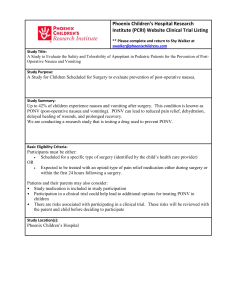


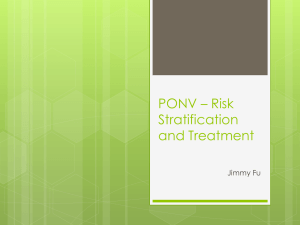
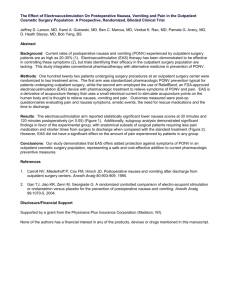
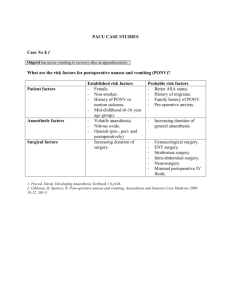
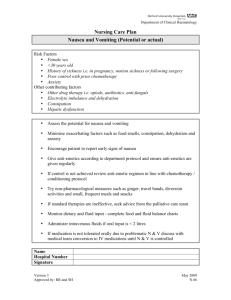
![[Physician Letterhead] [Select Today`s Date] . [Name of Health](http://s3.studylib.net/store/data/006995683_1-fc7d457c4956a00b3a5595efa89b67b0-300x300.png)
